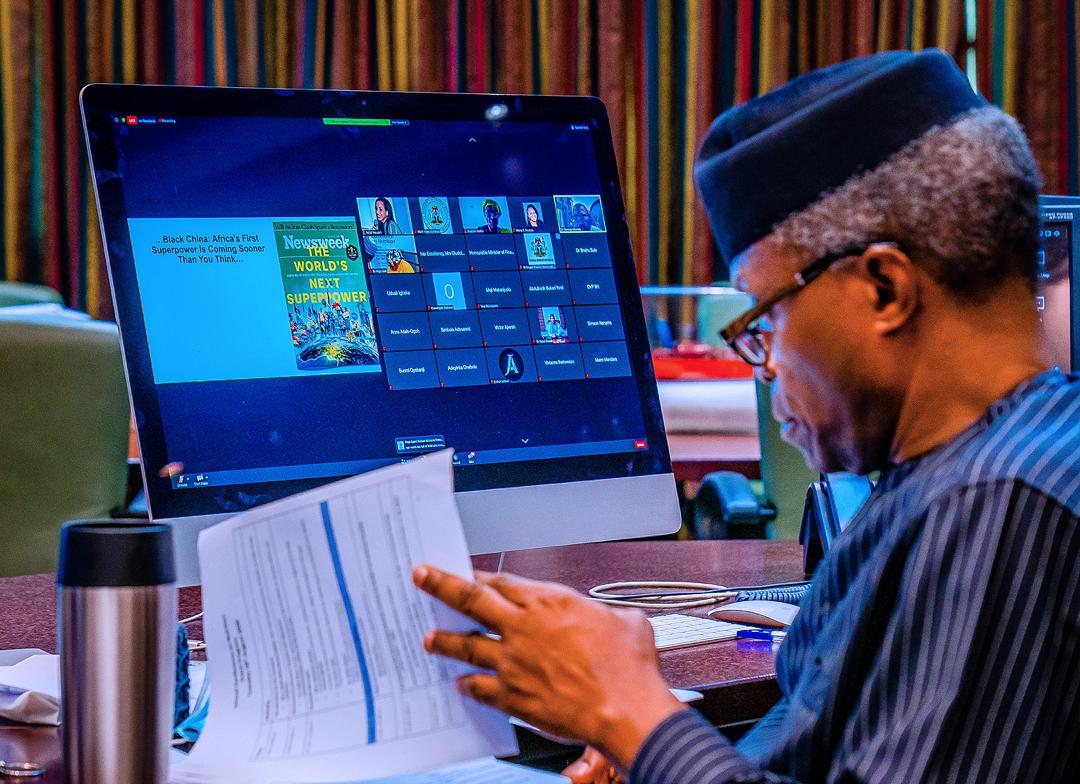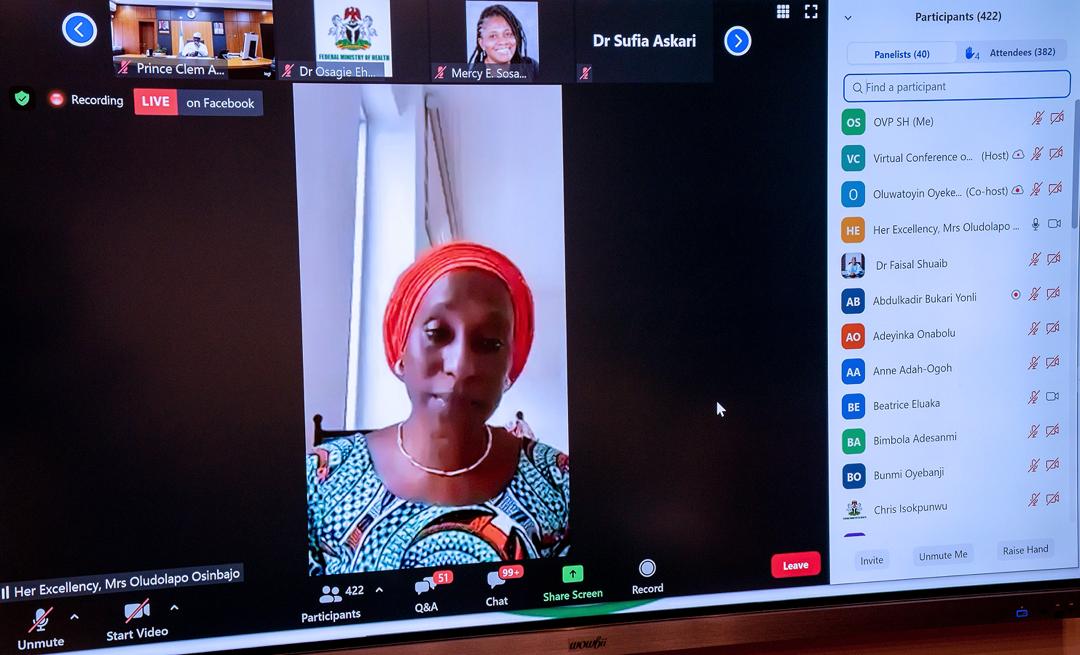VP’s Remarks At The 2020 Virtual Conference On Nutrition
REMARKS BY HIS EXCELLENCY, PROF. YEMI OSINBAJO, SAN, GCON, VICE PRESIDENT, FEDERAL REPUBLIC OF NIGERIA AT 2020 VIRTUAL CONFERENCE ON NUTRITION ON TUESDAY 18TH AUGUST 2020
The Aisha Buhari Foundation and its partners – the Federal Ministry of Health, Federal Ministry of Finance Budget and National Planning and the Nigerian Health Watch deserve every commendation for providing such an excellent opportunity for this important conversation on nutrition.
I must also commend Her Excellency, The First Lady, Mrs Aisha Buhari, who, with her well-known passion and empathy for causes that concern ordinary Nigerians, has convened this conference and continues to play major roles in this process.
The choice of the theme of the conference is an inspired one. It seeks to address one of the major challenges to turning around the depressing narrative on nutrition in Nigeria which is funding.
Perhaps it bears repeating that with malnutrition, we are confronted with a terrible scourge. One capable of defeating the present aspirations of millions of young Nigerians for healthy and productive lives. But worse, one that can jeopardise the physical and mental abilities of future generations since children are its most vulnerable victims.
While malnutrition is indeed a global problem, we in Nigeria have distinct factors that exacerbate the prevalence of malnutrition. The first is poverty which is both a cause and the consequence. But the story is worsened today by the effect of the economic downturn resulting from the COVID-19 pandemic. This has not only translated to massive job losses and supply chain disruptions but also a drop in income for the poor and the most vulnerable households resulting in diminishing nutritional status.
Second is the displacement of large populations especially children as a result of the insurgency in the northeast, and the banditry and conflict in the northwest. The persistence of these underlying issues increases the overall physical and material resources that will be required to deal with malnutrition.
What then can be done to innovatively provide resources for the battle against malnutrition?
In April 2016, this administration reviewed and adopted the National Food and Nutrition Policy, and inaugurated the National Council on Nutrition in 2017. The National Council on Nutrition (NCN), is charged with providing strategic direction, ensuring coordinated and aligned programming, coordinating innovative financing and accountability for Nutrition interventions.
Second, the administration has also ensured progressive increases in budgetary allocations to nutrition activities in the country. There has been an increased investment of about N3.8 billion by Federal and State governments especially for the procurement of Ready-to-Use Therapeutic Foods (RUTF).
Third, the revitalization of the PHC system with nutrition as the primary focus and the promotion of optimum breastfeeding and improved quality of complementary food.
Noticeably, there has been a decline in stunting and wasting. Stunting, from about 44% in 2017 to about 37% in 2019 and wasting from 10.8% in 2017 to 7% in 2019, and an increase in exclusive breastfeeding amongst children under 6 months from about 24% in 2017 to 29% in 2019.
Fourth, is our SIPs, particularly the HGSFP for public schools, it currently feeds over 9 million children across 34 States and the FCT, serving one nutritious meal every day; and our Conditional Cash Transfer Scheme that provides cash transfers to about 1.2 million beneficiaries so far, to boost income with the aim of improving the nutritional status for each household. The president recently ordered an increase in the number of those to benefit from the CCTs by another one million Nigerians.
But there is clearly a very long way to go. According to the nutritional costing study of the World Bank in Nigeria about 6 years ago, the cost per child is something in the order of $14.5 per child, arrived at by the variation in cost among the proven 10 nutrition interventions and the estimated number of beneficiaries.
This cost compares favourably to global estimates of $30 dollars per child calculated by the World Bank as of 2010. This estimate can be adopted for the baseline for 2020 and beyond, considering inflation and economic indices. We can adopt something in the region of $30 dollars or more.
At the national level, it is projected that the total additional public investment required to scale up 10 nutrition-specific interventions from current coverage levels to full coverage levels is estimated to be something in the order of $837 million.
Clearly, we need to increase domestic financing. And the only way to do so is to look more at what we can do at both the Federal and State levels. But more importantly, to direct funding to communities with the greatest needs.
I heard our civil society partners say that we need to do more about funding both federal and state. Some have alluded to a sum N800 million removed from the 2020 budget and they said that we should have this returned. I agree, but we must realize the fact that the Federal Government proposes a budget but the National Assembly may have a different view. But I think your advocacy before the National Assembly is crucial to drawing attention to what you consider as a priority. There are always several competing needs for resources and sometimes your strong voices especially directed as the debates that are going on can make a real difference in what ends up in the budgets, not just in the federal but even in the state budgets.
But budget funds from both states and federal governments cannot meet all of the needs. We believe that ultimately, the pool of funds from the mandatory health insurance programme will be an important contributor to financing nutrition. We need to aggregate a pool of fund outside the budget fund which is why our proposal for mandatory health insurance is one that we consider very important not just for health care but also for the nutrition interventions that we have proposed.
We look to donors to increase nutrition financing with a focus on equity by targeting populations that are most in need, including those that are fragile but have limited options for effective mobilizing of domestic finance for nutrition.
We also look to private corporations to absorb some of the costs for implementing nutrition programmes in areas such as fortification of foods, transportation of food and communication on behavioural change.
But raising funds may be fairly straightforward, the bigger problem is the efficient and transparent deployment of resources and coordinating the contributions of our local and international partners.
The Implementation of a new National Multi-Sectoral Plan of Action for Food and Nutrition (NMPFAN) will be an important part of restructuring our response to malnutrition.
The National Council on Nutrition has already approved the plan and it is awaiting budgetary projection before presentation for FEC approval.
The implementation of the plan will involve fully spelling out the role of the states, and other stakeholders. The most effective way of running the show will be to work with the States to develop their own specific plans and to channel support to the states in an organized and coordinated fashion.
Two other matters are critical: First is an investment in data management. We need data-driven action to efficiently target scarce resources to where it is most needed and this is not just at the federal level. The states also have to help in building the data that will be necessary for the kind of efficient allocation of resources that are desperately needed especially with the scarcity of resources.
Second is education, especially the education of women. There is unquestionably a correlation between levels of education of mothers and health and nutrition outcomes. It is important for us to educate them as vigorously as it is now being done both at the state and federal levels especially after the President declared that we must fully implement compulsory primary education in the first 9 years of a child’s school life. And this is especially targeted at the girl child.
So, I think it is important for us to ensure that women are educated especially that mothers are given the kind of information that will be required even in situations where there are high levels of poverty. Information on nutrition could still be very helpful in bringing about better outcomes than we are getting at the moment.
The journey to ending malnutrition need not be a long one. We can with effective collaboration, the sincerity of purpose and creativity reach our goals quickly. Funding will always be key but so also is reducing bureaucracy with common sense approaches and solutions.
I hope that our collective wisdom and experience at this conference will help to shed light on how to get the best results and move quickly.
Thank you very much and God bless you.




